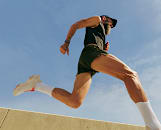
Nope, Yoga Isn’t the Same as Stretching — Here’s How the Two Workouts Stack Up
Our expert yoga instructors explain why you should be doing both.
By Colleen Travers, Team Peloton•
Yoga vs. Stretching: What’s the Difference?
Is Yoga or Stretching Better for You?
When You Should Stretch
When You Should Do Yoga
Do You Need to Do Yoga and Stretching?
You may think that because you regularly stretch after a workout you don’t need to do yoga. Or, perhaps you’ve gotten into the practice of a weekly yoga routine but aren’t in the habit of stretching after running or cycling. While yoga and stretching separately are great for recovery, these two activities shouldn’t be an either/or option.
Discover more ways to reach your goals with Peloton
In fact, in order to improve your fitness and crush your workouts you need them both to keep yourself in optimal shape.
Here, Peloton Yoga instructors Kristin McGee and Aditi Shah explain what the differences are between yoga vs. stretching and how they can together benefit your overall performance.
Yoga vs. Stretching: What’s the Difference?
First, let’s define both yoga and stretching. Yoga originates from ancient India and is a collection of physical, mental, and spiritual practices that aim to better the body and mind. While there are several different types of yoga, all involve a series of postures (known as asanas) tied to the breath.
Stretching, meanwhile, is a type of physical movement in which the goal is to lengthen a muscle as much as possible to improve flexibility and range of motion. There are two types of stretching: dynamic, which is a series of controlled movements, and passive, in which you hold a certain stretch for an extended period of time.
Now that you know the definitions of yoga vs. stretching, let’s dive deeper into their similarities and differences.

Similarities Between Yoga and Stretching
It’s no wonder many people confuse yoga and stretching. On the surface, they have a ton in common. Both yoga and stretching are often done to relieve muscle tightness and tension, for example. Both improve posture—yoga by strengthening the core, and stretching by improving the spine’s flexibility and range of motion.
Both can be full-body practices, although stretching focuses on one muscle group at a time while yoga can include full-body movements. Both will enhance your athletic performance by improving your flexibility and range of motion, and both can help with a better night of sleep.
Start working towards your fitness goals today.

Peloton App
Access thousands of classes with no equipment needed.
Breathing
Getting into the flow (no pun intended) of yoga will not only give you a solid workout, you’ll also learn how to focus on your breathing—a key tool you need to master in order to kick up the intensity in cardio-based circuits like high-intensity intervals, endurance rides or runs, and other workouts.
“The attention to breath is what makes yoga different from stretching,” says Kristin. “We focus on taking slow, deep, mindful breaths as we move in and out of or hold each yoga posture.” This combination of breathing while holding poses helps create a state of mental calmness while also working on increasing your strength and stamina, adds Aditi.
With stretching, meanwhile, you’re encouraged to breathe normally while holding static poses. You might find yourself holding your breath during uncomfortable stretches (especially if you’re just beginning your flexibility journey), and your main focus will be breathing in and out at a normal rate.
If anything, you’ll try to deepen your stretch during an exhale—but on the whole, yoga has much more intentional breathwork than stretching, making breathwork one of the key differences between yoga vs. stretching.
Engagement
Yoga generally requires a greater mental focus than simple stretching. That’s because yoga takes you through a series of poses meant to challenge your entire mind and body. You’ll quickly learn to turn your mental focus toward your body’s alignment, posture, and form during yoga classes, a skill known as proprioception that assists everything from better running form to learning how to engage your core during heavy climbs while cycling.
Yoga classes also feature breathwork techniques to help you tune into your body even more intentionally. In fact, almost all yoga classes include pranayama, which is a set of specific breathing exercises and patterns tied to movement or meditation.
Breathing may sound easy, since you do it unconsciously every day, but the small act of focusing on your inhales and exhales requires more mental engagement than you might think.
Stretching doesn’t explicitly call for any of the same mental engagement strategies as yoga. That’s not a knock on stretching—it can still be challenging! However, letting your mind wander during a 60-second forward fold is totally okay, and your main mental focus will be on keeping your breath even throughout the stretch.
Different Skills, Abilities, and Equipment
Finally, one last major difference between yoga vs. stretching lies in what skills levels they’re appropriate for and what equipment they require. While anybody can do yoga with thoughtful modifications, it is a full-body workout and certain styles (like vinyasa or power yoga) may be challenging for yoga beginners.
Stretching, meanwhile, is widely accessible to anyone and everyone, no matter their fitness level.
Stretching is also pretty approachable since it doesn’t require any equipment. Although a mat or a strap might be nice to assist you, they’re not completely necessary. For yoga, you will need a mat, and certain classes will call for props like blocks, straps, bolsters, or blankets.
Most of the time, you can use household items as substitutes if you don’t have these props (for example, a bathrobe strap can be used as a yoga strap). However, having the proper yoga equipment can really enhance your practice and allow you to fall deeper into the poses.
Is Yoga or Stretching Better for You?
Both yoga and stretching are part of a well-balanced workout routine, but depending on your specific fitness goals, you might prioritize one over the other.
For example, stretching focuses on specific muscle groups. If you’re experiencing tight hips or rounded shoulders, for example, you might practice specific stretches to address that muscle tension in a focused manner.
Or, if you’re looking to enhance your warm-up or cooldown during running, cycling, or strength training, you’ll likely turn to either dynamic or passive stretching (more on how to know when to stretch later).
On the other hand, yoga can really help enhance your mobility and flexibility at the same time. Remember, mobility and flexibility are closely linked together, but they are not the same thing. After all, you can have tight hamstrings but great mobility, being able to hinge forward at the hips with ease. Or you may experience the opposite, loose leg muscles but very limited movement as you hinge your hips forward.
“If you want to cycle further or run faster you need to be able to move your legs through their full range of motion (mobility) as well as not be limited by tightness in the muscles (flexibility) which could prevent you from recovering,” says Kristin. “Flexibility is more passive and can only be applied to a muscle so far as a joint has range of motion,” adds Aditi. “This makes mobility crucial in order to maintain range of motion of joints in the body. Ideally, mobility work happens before a workout so that you can work on strengthening into the space you create in your joints.”
Although dynamic stretching can help with mobility, the static stretching you do after a workout mostly works on flexibility, but yoga is able to focus on both in one session.
“Depending on the sequence you decide to do most yoga workouts have a mixture of poses that help mobility, flexibility, and ones that work on overall strength,” says Aditi.
The TL;DR: of whether yoga vs. stretching is better for you? It all depends on your goals and how you like to move. Whether you’re a daily runner or a dedicated strength trainer, there’s a stretching or yoga practice that will work for you.

When You Should Stretch
Stretching is best deployed before or after a separate workout, whether that’s cycling, running, strength training, or anything else. “Stretching is great for focusing on specific muscle groups right after or before a run, ride, or strength session,” says Kristin. “For instance, if you just did an upper body strength workout with Andy Speer, you then might choose a 10-minute upper body stretch class after. Or if you are heading out for a run with Becs Gentry you may want to open up your quads and hip flexors before with a 5-minute lower body stretch.”
There’s been a lot of debate over the years on whether you should stretch before or after a workout, but research suggests that it’s more about the type of stretching you’re doing that’s important.
A study published in The Journal of Strength and Conditioning Research found that dynamic stretching (moves like walking lunges or high knees) is best before a workout to prepare your body for exercise and boost your performance, while static stretches (like quad and hamstring stretches) are best for recovery post-workout.
When You Should Do Yoga
If you’re wondering where exactly to fit yoga into your already packed fitness schedule, consider it as an equivalent workout to strength training. “Yoga helps your build overall strength and mobility,” says Kristin. “Try it in place of a strength training session or even on recovery days.”
And while stretching helps prevent injury, Aditi says that yoga’s full-body approach makes it worth dedicating some workout time to it, even if you only have space for a 10-minute class on the Peloton App. “A good yoga class will help to mobilize the joints, stretch muscles, tone the organs, strengthen the body, breathe systematically, focus the mind, and so much more,” says Aditi. “You might find that a yoga practice even helps to build discipline, tolerance, and balance that you can take off of your mat.”
Do You Need to Do Yoga and Stretching?
Luckily, there’s no need to choose between yoga vs. stretching. Both have a place in any workout routine—it’s all about when and how you use them.
The good news is, you don’t have to commit to long, complicated yoga classes or stretching routines when you’re first adding them to your schedule. Try a simple 10-minute yoga flow before bed, or commit to a five-minute dynamic stretching warm-up before your next run. Then, after a few weeks of regular yoga and stretching, take stock of your body and see how you feel. Maybe you notice that your low back isn’t hurting as frequently, or that you’re sleeping better at night.
Regardless of your workout goals, your abilities, or your skill level, yoga and stretching will complement what you’re already doing and help enhance your performance—both in your workouts and in your functional, everyday movements.
Related Articles
This content is for informational and educational purposes only and does not constitute individualized advice. It is not intended to replace professional medical evaluation, diagnosis, or treatment. Seek the advice of your physician for questions you may have regarding your health or a medical condition. If you are having a medical emergency, call your physician or 911 immediately.
Want to strengthen your yoga practice?
We can help. Enter your email to get articles, instructor tips, and updates from Peloton sent to your inbox.
By providing your email address, you agree to receive marketing communications from Peloton.
For more about how we use your information, see our Privacy Policy.













